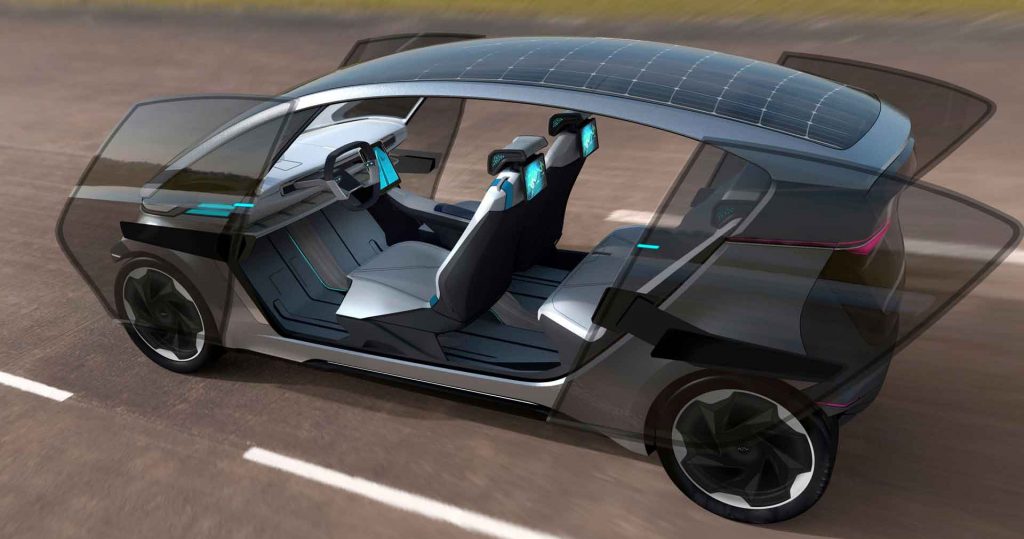Homegrown autonomous EV charges from solar panels in roof
Electric, self charging and autonomous. An Australian startup is reimagining the car.

ARENA has announced $2 million for Applied Electric Vehicles to advance their autonomous EV prototype towards commercialisation.
The Melbourne robotics startup has spent four years developing the innovative Modular Vehicle System to transport people and deliveries around urban areas.
It is designed to cover short distances at low speeds, but has a trump card – it can be charged by solar panels embedded into its roof.
The panels can provide up to 60 per cent of the vehicle’s energy needs. The energy is stored in a small battery, which unlike most EVs can be charged from a common 240V wall socket and doesn’t require any specialised charging infrastructure.
Each vehicle is built on a lightweight robotic base that can operate in either direction. A variety of ‘pods’ tailored to a range of purposes are planned to sit on top – from transporting passengers, to delivering goods or providing medical assistance.
The $7.65 million project will develop a prototype that demonstrates AEV’s technologies and is able to advance to the final stages of design and testing.
AEV’s CEO Julian Broadbent said he is excited to bring their technology to market.
“Our project with ARENA is focusing on passenger vehicles but the learnings will be applied to other vehicles, helping to reduce the charging infrastructure burden as EVs roll out globally,” Julian Broadbent said.
Broadbent previously worked at General Motors in the United States as the Director of Global Advanced Portfolio Planning and as Chief Mechanic to five-time V8 supercar champion Mark Skaife.
“The Modular Vehicle System will offer companies access to transport that is cost effective, pedestrian friendly, gentle on the environment and very customisable to their business needs,” he said.

“With ARENA’s assistance, we’ll be able to take our design to the next stage of development in utilising renewables for our autonomous electric vehicle and provide something potentially game changing in the low speed EV market.”
In January 2019, AEV’s driverless platform was showcased to a global audience at the CES 19 future tech convention in Las Vegas.
At the time, Broadbent described an “urgent need to rethink the way we move people, deliver goods and address on demand markets in cities.”
“Instead of adding technology to upgrade traditional cars, we’ve started from a clean sheet and built a completely new type of vehicle,” he said.
To develop some of the new lightweight components and manufacturing methods, Japanese high-tech materials producer Teijin Limited is partnering on the project.
How are we supporting the autonomous EV project?
ARENA’s funding will go towards tackling the energy related aspects of the new vehicle. This will include choosing the most suitable solar PV technology for the roof, as well as optimising the mass, energy efficiency and safety aspects of the cutting edge vehicle design.
ARENA CEO Darren Miller said the project is a great example of Australian innovation.
“AEV’s project could also unlock new applications for solar to be installed on, integrating it into curved surfaces and demonstrating that solar PV can directly power high-efficiency electric vehicles,” Darren Miller said.
ARENA has supported a range of electric vehicle projects, including the rollout of the Chargefox and Evie Networks intercity charging points.
“EVs are expected to play an important role in the coming decade in reducing the carbon footprint of transport. We hope to see AEV commercialise a homegrown driverless electric vehicle and be among the first to unlock the global driverless EV market,” he said.

“There is significant opportunity in the low speed vehicle market which is expected to gain considerable traction in both cities, campuses and factories over the next decade that AEV could tap into,” Mr Miller said.
LIKE THIS STORY? SIGN UP TO OUR NEWSLETTER

ARENA